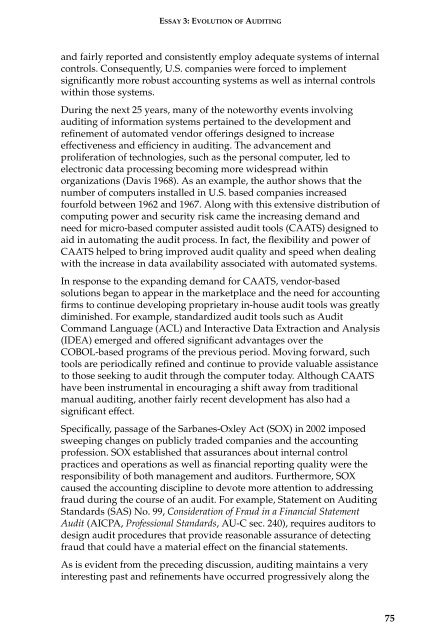AUDIT ANALYTICS AUDIT
1JWn3ix
1JWn3ix
You also want an ePaper? Increase the reach of your titles
YUMPU automatically turns print PDFs into web optimized ePapers that Google loves.
ESSAY 3: EVOLUTION OF <strong>AUDIT</strong>ING<br />
and fairly reported and consistently employ adequate systems of internal<br />
controls. Consequently, U.S. companies were forced to implement<br />
significantly more robust accounting systems as well as internal controls<br />
within those systems.<br />
During the next 25 years, many of the noteworthy events involving<br />
auditing of information systems pertained to the development and<br />
refinement of automated vendor offerings designed to increase<br />
effectiveness and efficiency in auditing. The advancement and<br />
proliferation of technologies, such as the personal computer, led to<br />
electronic data processing becoming more widespread within<br />
organizations (Davis 1968). As an example, the author shows that the<br />
number of computers installed in U.S. based companies increased<br />
fourfold between 1962 and 1967. Along with this extensive distribution of<br />
computing power and security risk came the increasing demand and<br />
need for micro-based computer assisted audit tools (CAATS) designed to<br />
aid in automating the audit process. In fact, the flexibility and power of<br />
CAATS helped to bring improved audit quality and speed when dealing<br />
with the increase in data availability associated with automated systems.<br />
In response to the expanding demand for CAATS, vendor-based<br />
solutions began to appear in the marketplace and the need for accounting<br />
firms to continue developing proprietary in-house audit tools was greatly<br />
diminished. For example, standardized audit tools such as Audit<br />
Command Language (ACL) and Interactive Data Extraction and Analysis<br />
(IDEA) emerged and offered significant advantages over the<br />
COBOL-based programs of the previous period. Moving forward, such<br />
tools are periodically refined and continue to provide valuable assistance<br />
to those seeking to audit through the computer today. Although CAATS<br />
have been instrumental in encouraging a shift away from traditional<br />
manual auditing, another fairly recent development has also had a<br />
significant effect.<br />
Specifically, passage of the Sarbanes-Oxley Act (SOX) in 2002 imposed<br />
sweeping changes on publicly traded companies and the accounting<br />
profession. SOX established that assurances about internal control<br />
practices and operations as well as financial reporting quality were the<br />
responsibility of both management and auditors. Furthermore, SOX<br />
caused the accounting discipline to devote more attention to addressing<br />
fraud during the course of an audit. For example, Statement on Auditing<br />
Standards (SAS) No. 99, Consideration of Fraud in a Financial Statement<br />
Audit (AICPA, Professional Standards, AU-C sec. 240), requires auditors to<br />
design audit procedures that provide reasonable assurance of detecting<br />
fraud that could have a material effect on the financial statements.<br />
As is evident from the preceding discussion, auditing maintains a very<br />
interesting past and refinements have occurred progressively along the<br />
75


